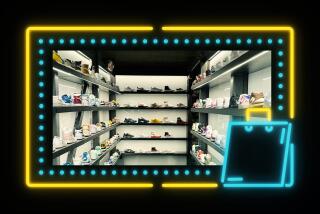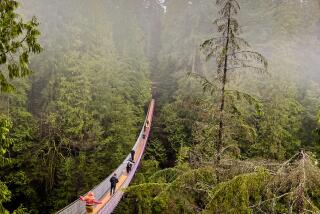Doing Business : The Edmonton Mall: Shoppers’ Paradise on the Prairie
- Share via
EDMONTON, Canada — In Xanadu did Kubla Khan
A stately pleasure-dome decree:
Where Alph, the sacred river, ran
Through caverns measureless to man
Down to a sunless sea. . . .
-- Samuel Coleridge
Xanadu this isn’t.
Nearly three-fourths of all Canadians live within 90 miles of the U.S. border. Of those who do not, some 785,000 live here in Edmonton, an improbably sited city on the wind-swept Alberta prairie, 54 degrees north latitude.
Montreal novelist Mordecai Richler once visited Edmonton and wrote that if Canada were a house, Montreal would be the salon, Vancouver would be the solarium and Edmonton would be the boiler room. British travel writer Jan Morris likewise arrived one bitter winter week, slithered on the icy sidewalks, got stuck in an elevator and wrote, “My spirit failed, and I crept away ashamed.”
No, it isn’t Xanadu. Yet Edmonton does manage to sustain a “pleasure-dome”--something no other city in modern times can boast. It’s the West Edmonton Mall, biggest in the world. And therein lies a mystery.
The West Edmonton Mall has more than 800 shops and smaller concessions, 19 movie theaters and more than 100 eateries. It has made the Guinness Book of World Records for 11 assorted superlatives. Walking from one end to the other is the equivalent of hoofing it eight city blocks.
The huge mall has the world’s largest indoor amusement park--complete with a 14-story roller coaster--the world’s largest indoor lake and the world’s largest indoor wave-pool, where the six-foot surf crashes hygienically on a sand-colored vinyl shore.
Not only is the West Edmonton Mall gigantic--it is also thought, by those who study such things, to represent a breakthrough in the annals of consumerism, one of 24 discrete new retail phenomena to have appeared in the selling industry’s modern history. (Other retailing quantum leaps include the franchise store, the fast-food chain and the shopping mall itself, which was born in Kansas City, Mo., in the 1920s.) The West Edmonton Mall is considered a breakthrough because it is the first to have combined, on a massive scale, the hypnosis of a mall with the fantasy of an amusement park.
“It’s a summation of 20th-Century (North) American culture,” said Brian Allsopp, an architect and the founder of the Edmonton Society for Architecture and Urban Studies. “It’s the automobile. It’s glitz. It’s lacking in any sort of artistic, cultural component at all.”
The West Edmonton Mall’s effects on the social and cultural fabric of this far-flung city have been the stuff that doctoral dissertations are made of. But at an economic level, there remains an unanswered question: How can the gigantic mall be turning a profit in Edmonton, which is not only smallish, as North American commercial and political centers go, but which also has the highest retail-space-to-population ratio in all Canada?
“In terms of straight performance, it doesn’t make sense,” said Allsopp, leaning over a brass-railed balcony in the mall’s west wing and gazing pensively into the coral-studded waters of the artificial lake.
The mall industry’s conventional wisdom, after all, has it that a so-called “super-regional mall” can work only near a city of 3 million or more. (Officially, malls range from the “super-regional” leviathans, with three or more full-fledged department stores, down to the humble “neighborhood malls,” little huddles of shops built alongside supermarkets. These various shopping centers are further categorized by what developers refer to as “GLA,” or gross leasable area; a super-regional mall might have 850,000 square feet of GLA.)
With its 3.8 million square feet of GLA, the West Edmonton Mall was nearly twice as big as the next largest mall on Earth (Woodfield Mall, near Chicago) at the time it was built. And that doesn’t include the rides, lakes, fountains, tropical-fish tanks and other non-leasable frills which occupy another 1.4 million square feet.
One study thus found that by all logic, Edmonton would have to have 12 million people for the West Edmonton Mall to return a profit to its developers, the Triple Five Corp.
So what is the secret?
The question looms large in the minds of mall developers and urban development specialists worldwide who have recessions to cope with and who are, often enough, watching their own local malls go into decline. Planners from afar have heard Triple Five boast that the West Edmonton Mall ripples with 15,000 employees and attracts 9 million tourists a year to the ranchlands and oil fields of central Alberta. And they wonder whether a massive, West Edmonton-Mall-style development would work its peculiar magic in their own recessed corners of the globe as well.
In the four years since this mall was completed, officials from Britain, Germany, the Soviet Union, Japan, eastern Canada and the United States have traveled to Edmonton to gape, contemplate and listen to pitches from Triple Five Corp.--which would be more than happy to build more mega-malls elsewhere given the right package of incentives.
“Most of them are overwhelmed, both by the thing itself and by the promotional spiel,” said Adam Finn, associate professor of marketing at the University of Alberta, who disputes some of Triple Five’s statistics, and who has occasionally counseled a shell-shocked foreigner in search of unvarnished mall data.
“It’s not in (Triple Five’s) interest to be accurate,” said Finn. “It’s in their interest to be the biggest and the best. (Out-of-town planners) are desperate for something besides the party line.”
So far, the only community to bite the Triple Five bait has been Bloomington, Minn., a suburb of Minneapolis. There, Triple Five, in a joint venture with two American developer-brothers, has broken ground for what is billed as the biggest mall in America.
Not only is it tricky to figure out whether the Edmonton mega-mall concept will work elsewhere; virtually no one outside the Triple Five Corp. knows whether it even works here.
The Triple Five Corp. is family-owned, which doesn’t help matters much: It doesn’t have to disclose profit-and-loss details. And the family in question, Iranian-born Jacob Ghermezian and his four sons, is notorious for its secrecy.
“They just arrived out of the blue with cash, with no history of business contacts in North America, and started buying land,” said Allsopp. “Other developers just kept asking, ‘Where are these guys getting the financing? We can’t afford to develop things like that.’ ”
With few facts to go by, analysts look for clues wherever they can find them. Finn points out that when the Ghermezians finished building the West Edmonton Mall, they tried to float a debenture issue to convert their costly building loans into cheaper long-term debt. But the offering was a bust; the target investors--big pension funds, insurance companies--weren’t interested.
Triple Five says that the West Edmonton Mall’s retail sales are the equivalent of $320-$330 per square foot of gross leasable area. That would indicate an annual volume of about $1.2 billion. By comparison, state figures put 1989 sales at Costa Mesa’s giant South Coast Plaza mall at $672 million, or about $302 per square foot.
In 1989, after some officials from Leeds, England, began should-we-build-a-mega-mall talks with Triple Five, University of Alberta marketing professor Clifton Young wrote a paper analyzing just what it is about Edmonton that lets the city sustain a mall so grotesquely out of whack with its own demographics. Factors turned out to include some of the very things that made Edmonton so forbidding to authors Richler and Morris: Its climate (Northerners appreciate the glass-domed vinyl beach on 40-below January days); its vulnerability to oil shocks (during the last one, desperate city officials showered Triple Five with subsidies, tax breaks, zoning concessions and land swaps); its geographic isolation (there is no rival mega-mall to the north, east or west).
Besides, said Young, “The populace of Edmonton has what can be called a ‘good’ mall ethic.” That is, however they may rail that the West Edmonton Mall is killing the downtown or mesmerizing teen-agers, they still harbor some residue of civic pride toward the place. They don’t throw trash, don’t vandalize the washrooms, don’t spray graffiti on the walls. That holds down Triple Five’s maintenance costs. And they do talk up the mall with their friends, and show it off to out-of-town guests.
Consider Allsopp. In the past, he has come out to fight the Ghermezians’ schemes at City Council meetings; now, he said he gets headaches walking through the West Edmonton Mall. “There’s no quick trip to the West Edmonton Mall,” he said. “You’re stuck in there, and you have to walk along in this big, behavioral maze.”
Yet for all that, Allsopp won’t condemn the West Edmonton Mall. It has, he notes, put the Albertan capital on a merchandising par with some of the world’s most famous commercial meccas.
“Look at the bags,” he said, referring to the advertising on one store’s carryalls. “They say, ‘Rome, Paris, New York, London, Toronto--and Edmonton.’ It doesn’t make sense.”
In Edmonton, It’s at the Mall The West Edmonton Mall--all 5.5 million square feet of it--provides 15,000 permanent jobs and provides more than $250 million annually to Canada’s national economy. The mall features: More than 800 shops 110 eateries 19 movie theaters 5 amusement parks 1 hotel and resort 1 minature golf course 1 indoor ice rink 1 wave pool with 22 water slides 1 bingo hall 1 nightclub 1 petting zoo 1 family billiards hall
More to Read
Sign up for Essential California
The most important California stories and recommendations in your inbox every morning.
You may occasionally receive promotional content from the Los Angeles Times.










